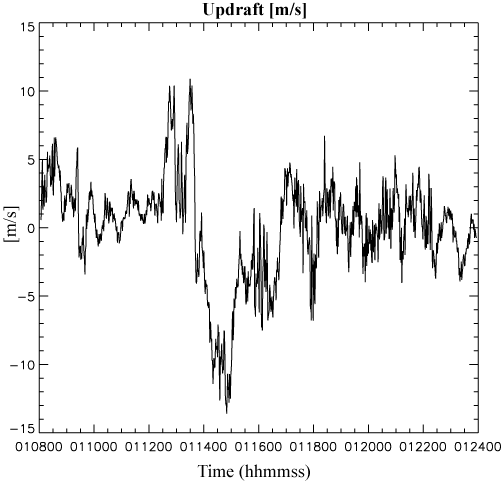Updraft measurements can be derived from aircraft rate-of-climb values obtained by differentiating the static pressure (altitude) values or from direct rate-of-climb measurements made with a Ball variometer. The altitude differentiation approach is normally used to get the rate-of-climb values. The variometer is not used as the primary sensor because it has a limited range (+- 30 m/s) and becomes nonlinear near the ends of this range. It also has an inaccuracy near the zero point which results in a reading of -3 m/s when the actual value is between +- 3 m/s. If the rate-of-climb is outside the +- 3 m/s range and within the +- 30 m/s limit, the instrument functions properly and the data can be used for backup purposes.
The simplest approach to updraft calculation is an expansion of the concept used by Auer and Sand (1966); some of the aircraft-induced vertical motions are removed during post-flight processing of the data by correcting the rate-of-climb values for the effects of airspeed and engine power variations. An additional term based on energy conservation considerations ( Dye and Toutenhoofd , 1973; Cooper , 1978) can be applied to correct further for pilot-induced effects. In this manner, the larger-scale updrafts can be measured with an estimated accuracy of better than +- 3 m/s or 10%, whichever is larger. Small-scale motions (i.e., gusts) with horizontal dimensions smaller than 0.5 km or so are below the sensitivity of this relatively simple system.
An improved method of calculating updraft speeds from the T-28 measurements has been developed by Kopp (1985) based on earlier work by Lenschow (1976). It uses the aircraft equations of motion to obtain a better correction for the aircraft-induced motions. The required measurements are static pressure, dynamic pressure, and pitch angle. Estimated accuracy is +- 3 m/s and spatial resolution is ~0.5 km. The Kopp method works by setting base conditions for level flight in static air. Under these conditions, a change in aircraft pitch would yield a change in altitude. In conditions of updraft or downdraft, the pilot must compensate for the additional force acting upon the plane by increaseing or decreasing the pitch. This creates the condition where the current pitch does not match the "theoretical" pitch for the current rate of change in altitude. The amount of force being applied to the plane is inferred by comparing the measured rate of change in altitude to the calculated change in static air for the measured pitch. From this force value, the vertical wind speed can be estimated.
One downfall of the Kopp method is that it is not valid during turns or other situations with artificial acclerations. In Figure 1 below, the pronounced negative vertical wind episode beginning around 01:14 and continuing through 01:17 is an artifact generated by a turn. As the pilot entered the turn, he pitches the nose upward to counter the accelating force of the turn. Since there is an increse in pitch, but no accompanied increase in altitude, the Kopp algorithm reads the event as a strong downdraft.

Figure 1: Artifact in Kopp vertical windspeed due to acceleration due to turning
Redundancy is an important feature of the T-28 instrumentation system. Only a few storms a year can be studied in detail and the data are sufficiently important to warrant the maintenance of back-up instrumentation. For determinations of vertical air motion, for example, the variometer (rate-of-climb indicator) output is used in the event of a malfunction of the Rosemount pressure sensors. If both pressure instruments and the variometer should fail, the accelerometer data could be integrated to determine rate of climb.
